Leverage (Debt-Capital Ratio) Impact on Petroleum Firms in Australia
VerifiedAdded on 2023/04/19
|15
|3524
|306
Report
AI Summary
This report investigates the relationship between capital structure (debt-equity ratio) and the financial performance of companies in the Australian petroleum industry. It examines the theoretical models explaining this relationship, such as the Tradeoff theory, Pecking Order Theory, and Agen...
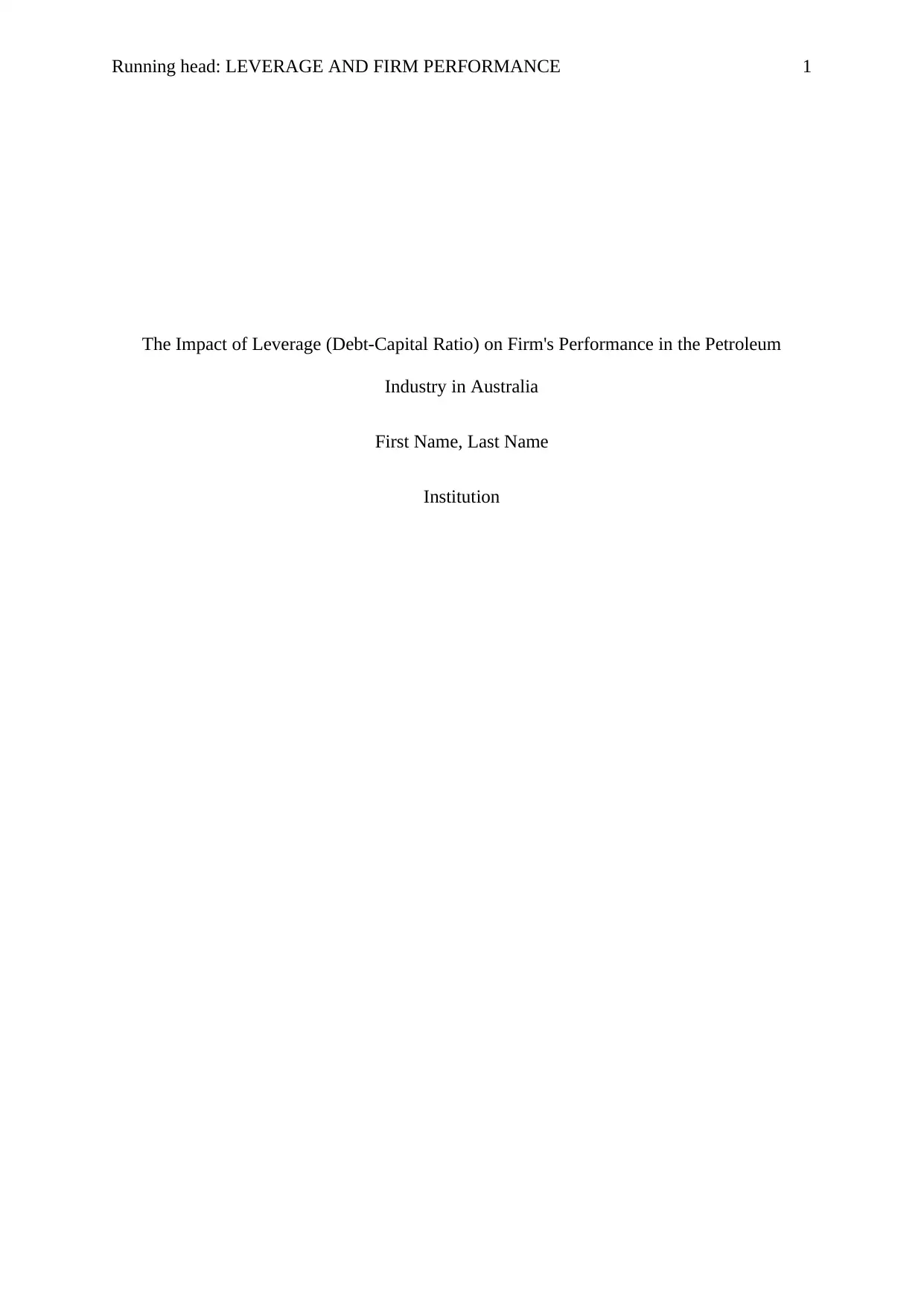
Running head: LEVERAGE AND FIRM PERFORMANCE 1
The Impact of Leverage (Debt-Capital Ratio) on Firm's Performance in the Petroleum
Industry in Australia
First Name, Last Name
Institution
The Impact of Leverage (Debt-Capital Ratio) on Firm's Performance in the Petroleum
Industry in Australia
First Name, Last Name
Institution
Paraphrase This Document
Need a fresh take? Get an instant paraphrase of this document with our AI Paraphraser

EFFECT OF LEVERAGE ON FIRM PERFORMANCE IN AUSTRALIA 2
Table of Contents
Introduction................................................................................................................................3
Background Information............................................................................................................3
Preliminary Critical Literature Review......................................................................................3
Purpose/ Aim of the Study.........................................................................................................6
Methodology..............................................................................................................................7
Type of Data...............................................................................................................................7
Source of Data............................................................................................................................8
Population/ Sampling.................................................................................................................8
Variable/ Themes.......................................................................................................................8
Data Analysis.............................................................................................................................9
Research Plan.............................................................................................................................9
Conclusion................................................................................................................................10
References................................................................................................................................11
Table of Contents
Introduction................................................................................................................................3
Background Information............................................................................................................3
Preliminary Critical Literature Review......................................................................................3
Purpose/ Aim of the Study.........................................................................................................6
Methodology..............................................................................................................................7
Type of Data...............................................................................................................................7
Source of Data............................................................................................................................8
Population/ Sampling.................................................................................................................8
Variable/ Themes.......................................................................................................................8
Data Analysis.............................................................................................................................9
Research Plan.............................................................................................................................9
Conclusion................................................................................................................................10
References................................................................................................................................11
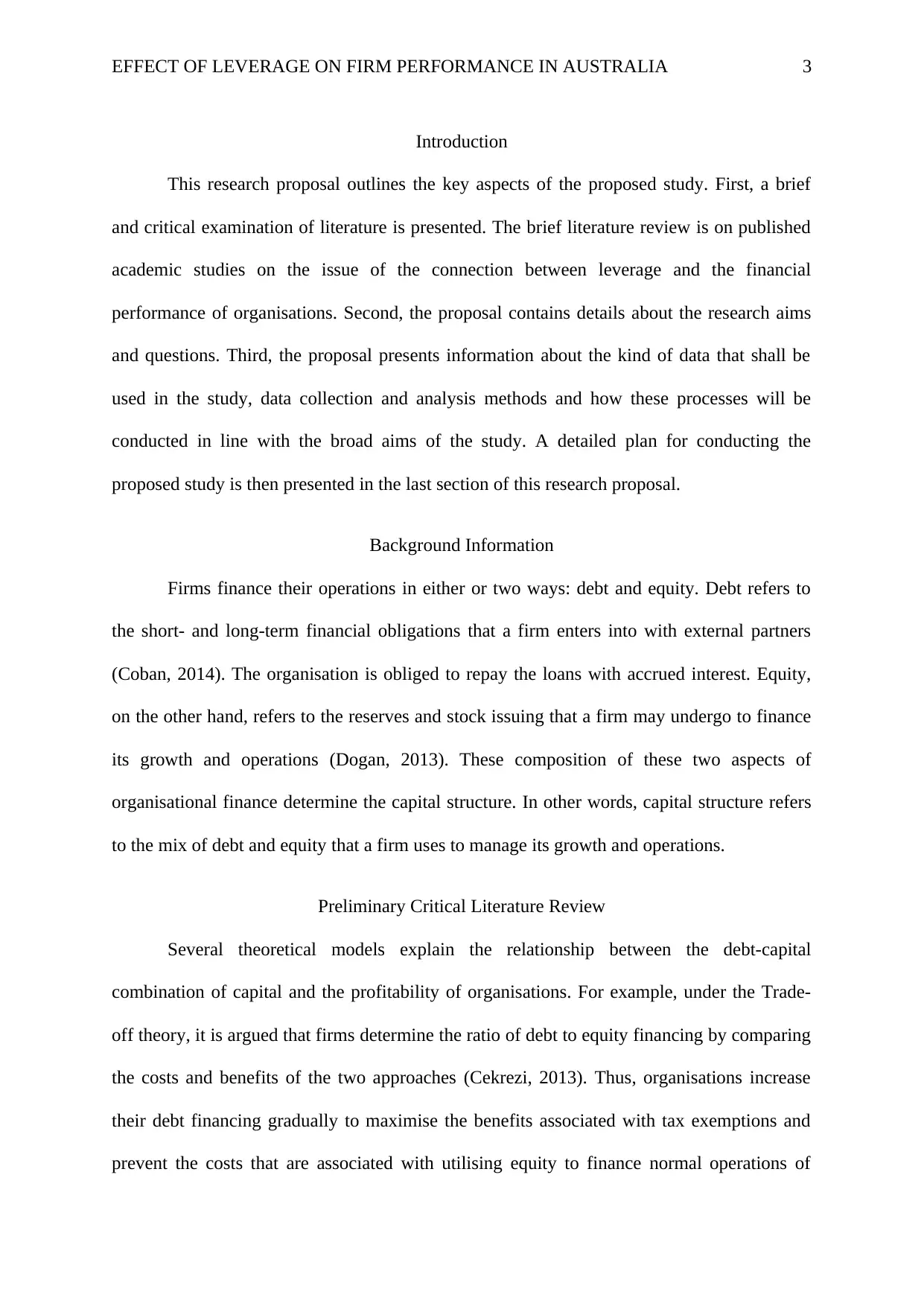
EFFECT OF LEVERAGE ON FIRM PERFORMANCE IN AUSTRALIA 3
Introduction
This research proposal outlines the key aspects of the proposed study. First, a brief
and critical examination of literature is presented. The brief literature review is on published
academic studies on the issue of the connection between leverage and the financial
performance of organisations. Second, the proposal contains details about the research aims
and questions. Third, the proposal presents information about the kind of data that shall be
used in the study, data collection and analysis methods and how these processes will be
conducted in line with the broad aims of the study. A detailed plan for conducting the
proposed study is then presented in the last section of this research proposal.
Background Information
Firms finance their operations in either or two ways: debt and equity. Debt refers to
the short- and long-term financial obligations that a firm enters into with external partners
(Coban, 2014). The organisation is obliged to repay the loans with accrued interest. Equity,
on the other hand, refers to the reserves and stock issuing that a firm may undergo to finance
its growth and operations (Dogan, 2013). These composition of these two aspects of
organisational finance determine the capital structure. In other words, capital structure refers
to the mix of debt and equity that a firm uses to manage its growth and operations.
Preliminary Critical Literature Review
Several theoretical models explain the relationship between the debt-capital
combination of capital and the profitability of organisations. For example, under the Trade-
off theory, it is argued that firms determine the ratio of debt to equity financing by comparing
the costs and benefits of the two approaches (Cekrezi, 2013). Thus, organisations increase
their debt financing gradually to maximise the benefits associated with tax exemptions and
prevent the costs that are associated with utilising equity to finance normal operations of
Introduction
This research proposal outlines the key aspects of the proposed study. First, a brief
and critical examination of literature is presented. The brief literature review is on published
academic studies on the issue of the connection between leverage and the financial
performance of organisations. Second, the proposal contains details about the research aims
and questions. Third, the proposal presents information about the kind of data that shall be
used in the study, data collection and analysis methods and how these processes will be
conducted in line with the broad aims of the study. A detailed plan for conducting the
proposed study is then presented in the last section of this research proposal.
Background Information
Firms finance their operations in either or two ways: debt and equity. Debt refers to
the short- and long-term financial obligations that a firm enters into with external partners
(Coban, 2014). The organisation is obliged to repay the loans with accrued interest. Equity,
on the other hand, refers to the reserves and stock issuing that a firm may undergo to finance
its growth and operations (Dogan, 2013). These composition of these two aspects of
organisational finance determine the capital structure. In other words, capital structure refers
to the mix of debt and equity that a firm uses to manage its growth and operations.
Preliminary Critical Literature Review
Several theoretical models explain the relationship between the debt-capital
combination of capital and the profitability of organisations. For example, under the Trade-
off theory, it is argued that firms determine the ratio of debt to equity financing by comparing
the costs and benefits of the two approaches (Cekrezi, 2013). Thus, organisations increase
their debt financing gradually to maximise the benefits associated with tax exemptions and
prevent the costs that are associated with utilising equity to finance normal operations of
⊘ This is a preview!⊘
Do you want full access?
Subscribe today to unlock all pages.

Trusted by 1+ million students worldwide
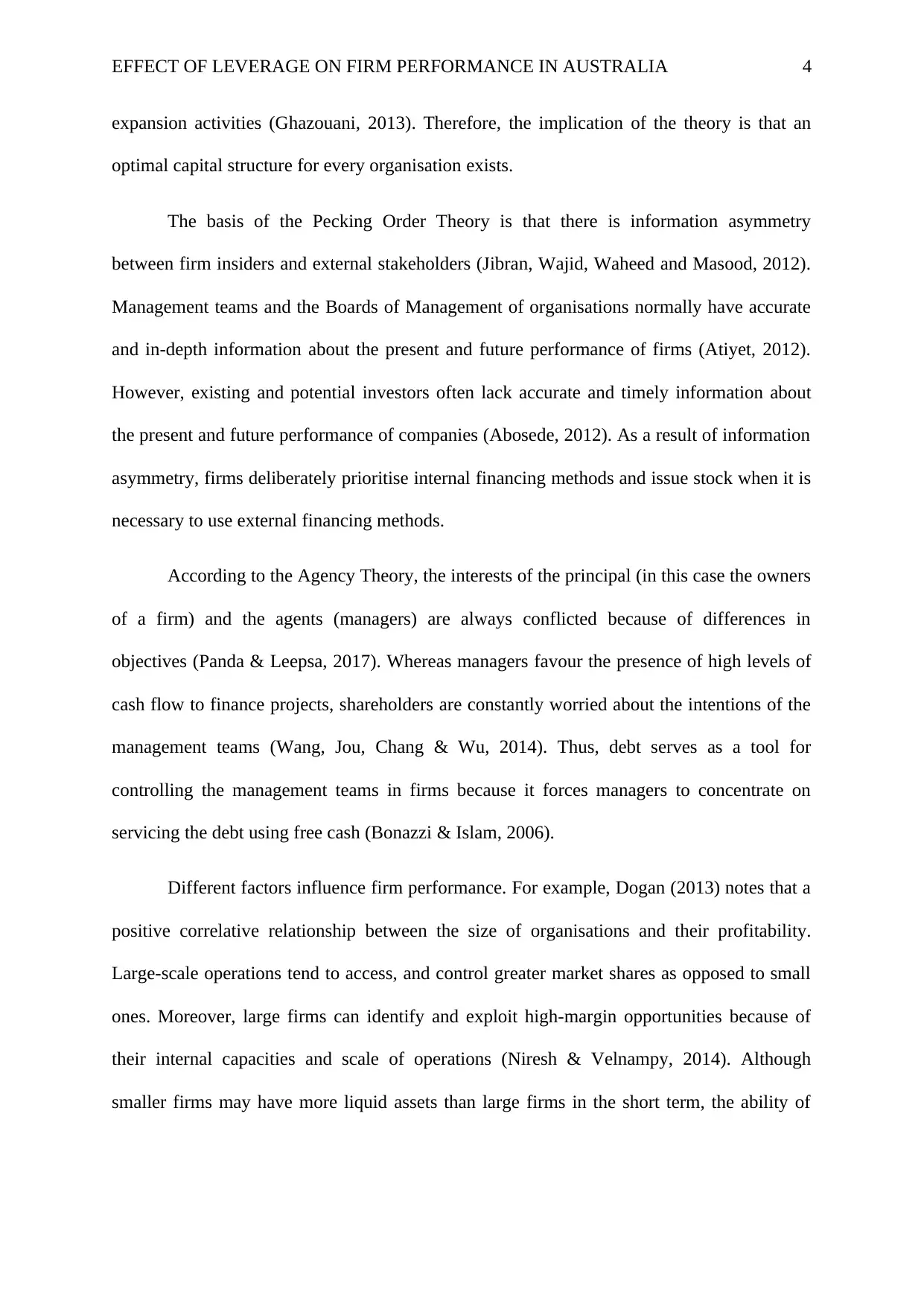
EFFECT OF LEVERAGE ON FIRM PERFORMANCE IN AUSTRALIA 4
expansion activities (Ghazouani, 2013). Therefore, the implication of the theory is that an
optimal capital structure for every organisation exists.
The basis of the Pecking Order Theory is that there is information asymmetry
between firm insiders and external stakeholders (Jibran, Wajid, Waheed and Masood, 2012).
Management teams and the Boards of Management of organisations normally have accurate
and in-depth information about the present and future performance of firms (Atiyet, 2012).
However, existing and potential investors often lack accurate and timely information about
the present and future performance of companies (Abosede, 2012). As a result of information
asymmetry, firms deliberately prioritise internal financing methods and issue stock when it is
necessary to use external financing methods.
According to the Agency Theory, the interests of the principal (in this case the owners
of a firm) and the agents (managers) are always conflicted because of differences in
objectives (Panda & Leepsa, 2017). Whereas managers favour the presence of high levels of
cash flow to finance projects, shareholders are constantly worried about the intentions of the
management teams (Wang, Jou, Chang & Wu, 2014). Thus, debt serves as a tool for
controlling the management teams in firms because it forces managers to concentrate on
servicing the debt using free cash (Bonazzi & Islam, 2006).
Different factors influence firm performance. For example, Dogan (2013) notes that a
positive correlative relationship between the size of organisations and their profitability.
Large-scale operations tend to access, and control greater market shares as opposed to small
ones. Moreover, large firms can identify and exploit high-margin opportunities because of
their internal capacities and scale of operations (Niresh & Velnampy, 2014). Although
smaller firms may have more liquid assets than large firms in the short term, the ability of
expansion activities (Ghazouani, 2013). Therefore, the implication of the theory is that an
optimal capital structure for every organisation exists.
The basis of the Pecking Order Theory is that there is information asymmetry
between firm insiders and external stakeholders (Jibran, Wajid, Waheed and Masood, 2012).
Management teams and the Boards of Management of organisations normally have accurate
and in-depth information about the present and future performance of firms (Atiyet, 2012).
However, existing and potential investors often lack accurate and timely information about
the present and future performance of companies (Abosede, 2012). As a result of information
asymmetry, firms deliberately prioritise internal financing methods and issue stock when it is
necessary to use external financing methods.
According to the Agency Theory, the interests of the principal (in this case the owners
of a firm) and the agents (managers) are always conflicted because of differences in
objectives (Panda & Leepsa, 2017). Whereas managers favour the presence of high levels of
cash flow to finance projects, shareholders are constantly worried about the intentions of the
management teams (Wang, Jou, Chang & Wu, 2014). Thus, debt serves as a tool for
controlling the management teams in firms because it forces managers to concentrate on
servicing the debt using free cash (Bonazzi & Islam, 2006).
Different factors influence firm performance. For example, Dogan (2013) notes that a
positive correlative relationship between the size of organisations and their profitability.
Large-scale operations tend to access, and control greater market shares as opposed to small
ones. Moreover, large firms can identify and exploit high-margin opportunities because of
their internal capacities and scale of operations (Niresh & Velnampy, 2014). Although
smaller firms may have more liquid assets than large firms in the short term, the ability of
Paraphrase This Document
Need a fresh take? Get an instant paraphrase of this document with our AI Paraphraser
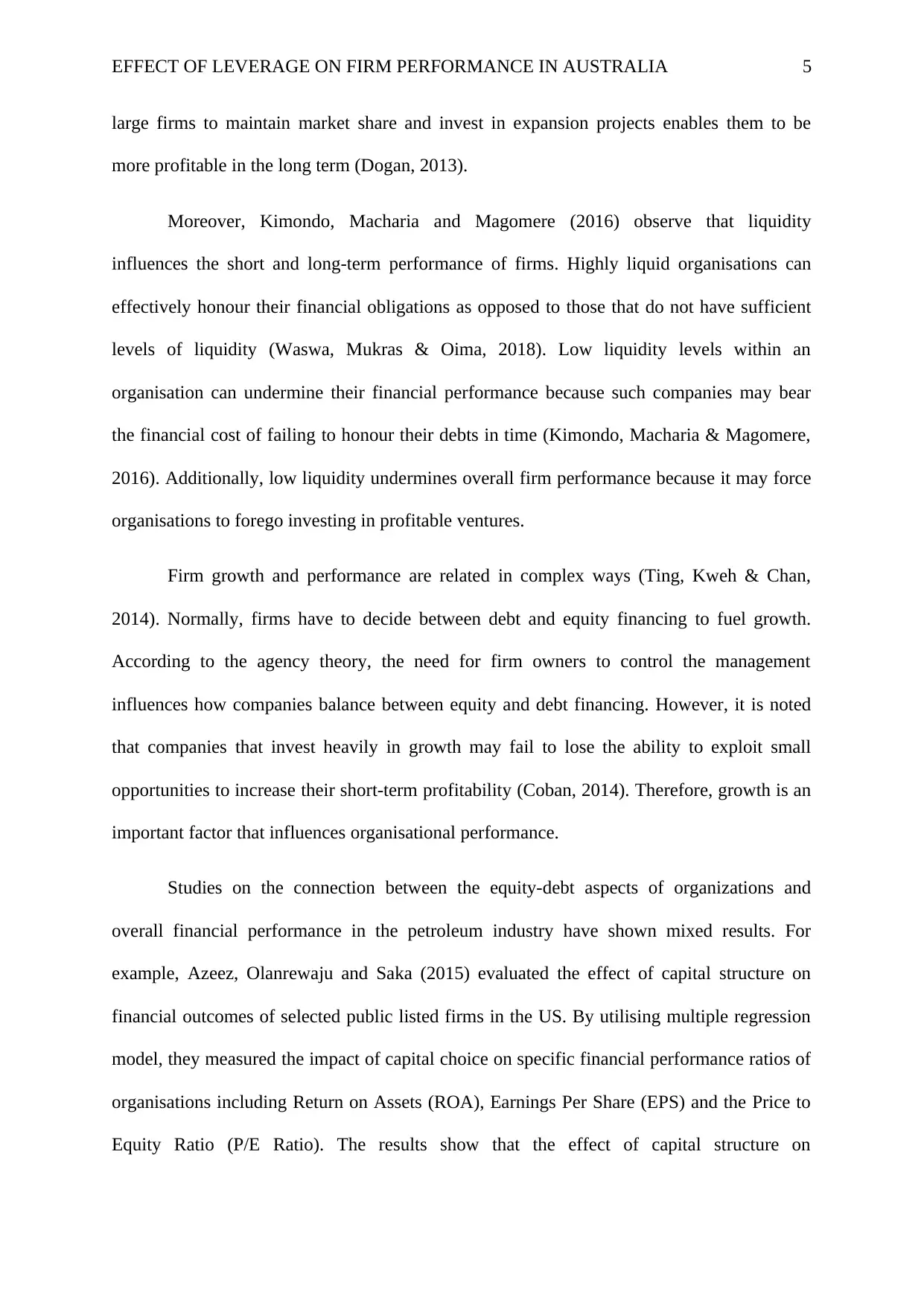
EFFECT OF LEVERAGE ON FIRM PERFORMANCE IN AUSTRALIA 5
large firms to maintain market share and invest in expansion projects enables them to be
more profitable in the long term (Dogan, 2013).
Moreover, Kimondo, Macharia and Magomere (2016) observe that liquidity
influences the short and long-term performance of firms. Highly liquid organisations can
effectively honour their financial obligations as opposed to those that do not have sufficient
levels of liquidity (Waswa, Mukras & Oima, 2018). Low liquidity levels within an
organisation can undermine their financial performance because such companies may bear
the financial cost of failing to honour their debts in time (Kimondo, Macharia & Magomere,
2016). Additionally, low liquidity undermines overall firm performance because it may force
organisations to forego investing in profitable ventures.
Firm growth and performance are related in complex ways (Ting, Kweh & Chan,
2014). Normally, firms have to decide between debt and equity financing to fuel growth.
According to the agency theory, the need for firm owners to control the management
influences how companies balance between equity and debt financing. However, it is noted
that companies that invest heavily in growth may fail to lose the ability to exploit small
opportunities to increase their short-term profitability (Coban, 2014). Therefore, growth is an
important factor that influences organisational performance.
Studies on the connection between the equity-debt aspects of organizations and
overall financial performance in the petroleum industry have shown mixed results. For
example, Azeez, Olanrewaju and Saka (2015) evaluated the effect of capital structure on
financial outcomes of selected public listed firms in the US. By utilising multiple regression
model, they measured the impact of capital choice on specific financial performance ratios of
organisations including Return on Assets (ROA), Earnings Per Share (EPS) and the Price to
Equity Ratio (P/E Ratio). The results show that the effect of capital structure on
large firms to maintain market share and invest in expansion projects enables them to be
more profitable in the long term (Dogan, 2013).
Moreover, Kimondo, Macharia and Magomere (2016) observe that liquidity
influences the short and long-term performance of firms. Highly liquid organisations can
effectively honour their financial obligations as opposed to those that do not have sufficient
levels of liquidity (Waswa, Mukras & Oima, 2018). Low liquidity levels within an
organisation can undermine their financial performance because such companies may bear
the financial cost of failing to honour their debts in time (Kimondo, Macharia & Magomere,
2016). Additionally, low liquidity undermines overall firm performance because it may force
organisations to forego investing in profitable ventures.
Firm growth and performance are related in complex ways (Ting, Kweh & Chan,
2014). Normally, firms have to decide between debt and equity financing to fuel growth.
According to the agency theory, the need for firm owners to control the management
influences how companies balance between equity and debt financing. However, it is noted
that companies that invest heavily in growth may fail to lose the ability to exploit small
opportunities to increase their short-term profitability (Coban, 2014). Therefore, growth is an
important factor that influences organisational performance.
Studies on the connection between the equity-debt aspects of organizations and
overall financial performance in the petroleum industry have shown mixed results. For
example, Azeez, Olanrewaju and Saka (2015) evaluated the effect of capital structure on
financial outcomes of selected public listed firms in the US. By utilising multiple regression
model, they measured the impact of capital choice on specific financial performance ratios of
organisations including Return on Assets (ROA), Earnings Per Share (EPS) and the Price to
Equity Ratio (P/E Ratio). The results show that the effect of capital structure on
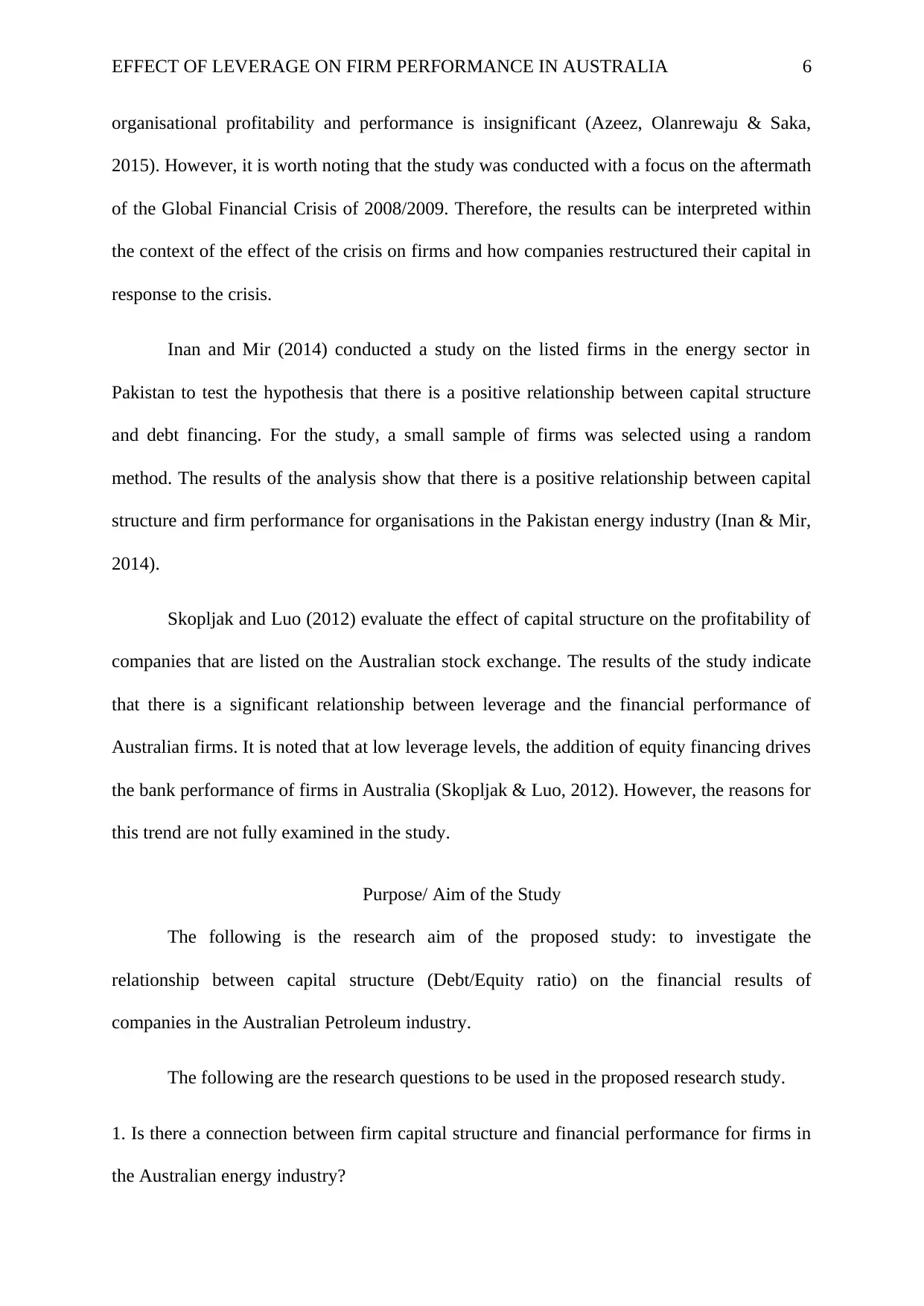
EFFECT OF LEVERAGE ON FIRM PERFORMANCE IN AUSTRALIA 6
organisational profitability and performance is insignificant (Azeez, Olanrewaju & Saka,
2015). However, it is worth noting that the study was conducted with a focus on the aftermath
of the Global Financial Crisis of 2008/2009. Therefore, the results can be interpreted within
the context of the effect of the crisis on firms and how companies restructured their capital in
response to the crisis.
Inan and Mir (2014) conducted a study on the listed firms in the energy sector in
Pakistan to test the hypothesis that there is a positive relationship between capital structure
and debt financing. For the study, a small sample of firms was selected using a random
method. The results of the analysis show that there is a positive relationship between capital
structure and firm performance for organisations in the Pakistan energy industry (Inan & Mir,
2014).
Skopljak and Luo (2012) evaluate the effect of capital structure on the profitability of
companies that are listed on the Australian stock exchange. The results of the study indicate
that there is a significant relationship between leverage and the financial performance of
Australian firms. It is noted that at low leverage levels, the addition of equity financing drives
the bank performance of firms in Australia (Skopljak & Luo, 2012). However, the reasons for
this trend are not fully examined in the study.
Purpose/ Aim of the Study
The following is the research aim of the proposed study: to investigate the
relationship between capital structure (Debt/Equity ratio) on the financial results of
companies in the Australian Petroleum industry.
The following are the research questions to be used in the proposed research study.
1. Is there a connection between firm capital structure and financial performance for firms in
the Australian energy industry?
organisational profitability and performance is insignificant (Azeez, Olanrewaju & Saka,
2015). However, it is worth noting that the study was conducted with a focus on the aftermath
of the Global Financial Crisis of 2008/2009. Therefore, the results can be interpreted within
the context of the effect of the crisis on firms and how companies restructured their capital in
response to the crisis.
Inan and Mir (2014) conducted a study on the listed firms in the energy sector in
Pakistan to test the hypothesis that there is a positive relationship between capital structure
and debt financing. For the study, a small sample of firms was selected using a random
method. The results of the analysis show that there is a positive relationship between capital
structure and firm performance for organisations in the Pakistan energy industry (Inan & Mir,
2014).
Skopljak and Luo (2012) evaluate the effect of capital structure on the profitability of
companies that are listed on the Australian stock exchange. The results of the study indicate
that there is a significant relationship between leverage and the financial performance of
Australian firms. It is noted that at low leverage levels, the addition of equity financing drives
the bank performance of firms in Australia (Skopljak & Luo, 2012). However, the reasons for
this trend are not fully examined in the study.
Purpose/ Aim of the Study
The following is the research aim of the proposed study: to investigate the
relationship between capital structure (Debt/Equity ratio) on the financial results of
companies in the Australian Petroleum industry.
The following are the research questions to be used in the proposed research study.
1. Is there a connection between firm capital structure and financial performance for firms in
the Australian energy industry?
⊘ This is a preview!⊘
Do you want full access?
Subscribe today to unlock all pages.

Trusted by 1+ million students worldwide
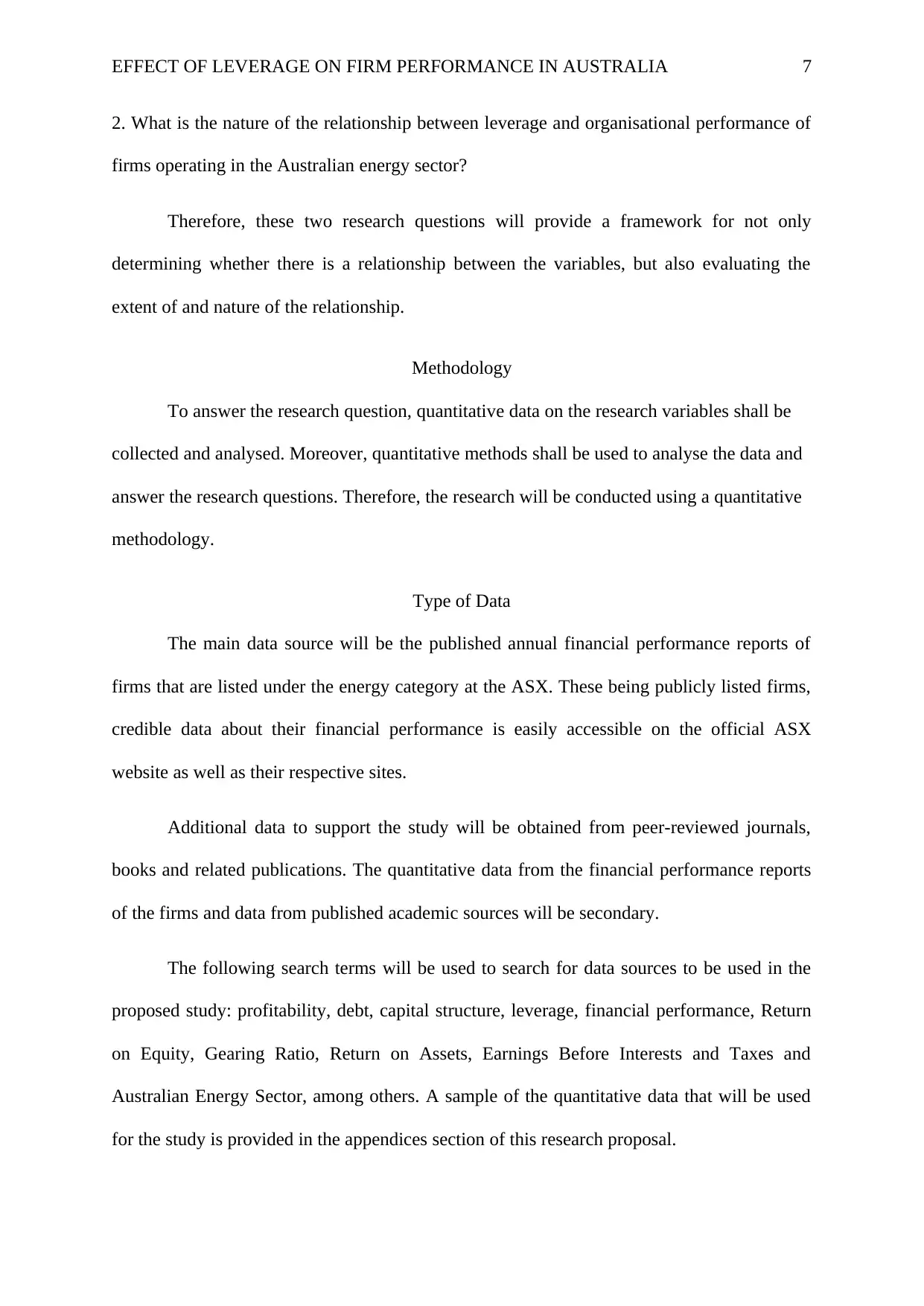
EFFECT OF LEVERAGE ON FIRM PERFORMANCE IN AUSTRALIA 7
2. What is the nature of the relationship between leverage and organisational performance of
firms operating in the Australian energy sector?
Therefore, these two research questions will provide a framework for not only
determining whether there is a relationship between the variables, but also evaluating the
extent of and nature of the relationship.
Methodology
To answer the research question, quantitative data on the research variables shall be
collected and analysed. Moreover, quantitative methods shall be used to analyse the data and
answer the research questions. Therefore, the research will be conducted using a quantitative
methodology.
Type of Data
The main data source will be the published annual financial performance reports of
firms that are listed under the energy category at the ASX. These being publicly listed firms,
credible data about their financial performance is easily accessible on the official ASX
website as well as their respective sites.
Additional data to support the study will be obtained from peer-reviewed journals,
books and related publications. The quantitative data from the financial performance reports
of the firms and data from published academic sources will be secondary.
The following search terms will be used to search for data sources to be used in the
proposed study: profitability, debt, capital structure, leverage, financial performance, Return
on Equity, Gearing Ratio, Return on Assets, Earnings Before Interests and Taxes and
Australian Energy Sector, among others. A sample of the quantitative data that will be used
for the study is provided in the appendices section of this research proposal.
2. What is the nature of the relationship between leverage and organisational performance of
firms operating in the Australian energy sector?
Therefore, these two research questions will provide a framework for not only
determining whether there is a relationship between the variables, but also evaluating the
extent of and nature of the relationship.
Methodology
To answer the research question, quantitative data on the research variables shall be
collected and analysed. Moreover, quantitative methods shall be used to analyse the data and
answer the research questions. Therefore, the research will be conducted using a quantitative
methodology.
Type of Data
The main data source will be the published annual financial performance reports of
firms that are listed under the energy category at the ASX. These being publicly listed firms,
credible data about their financial performance is easily accessible on the official ASX
website as well as their respective sites.
Additional data to support the study will be obtained from peer-reviewed journals,
books and related publications. The quantitative data from the financial performance reports
of the firms and data from published academic sources will be secondary.
The following search terms will be used to search for data sources to be used in the
proposed study: profitability, debt, capital structure, leverage, financial performance, Return
on Equity, Gearing Ratio, Return on Assets, Earnings Before Interests and Taxes and
Australian Energy Sector, among others. A sample of the quantitative data that will be used
for the study is provided in the appendices section of this research proposal.
Paraphrase This Document
Need a fresh take? Get an instant paraphrase of this document with our AI Paraphraser
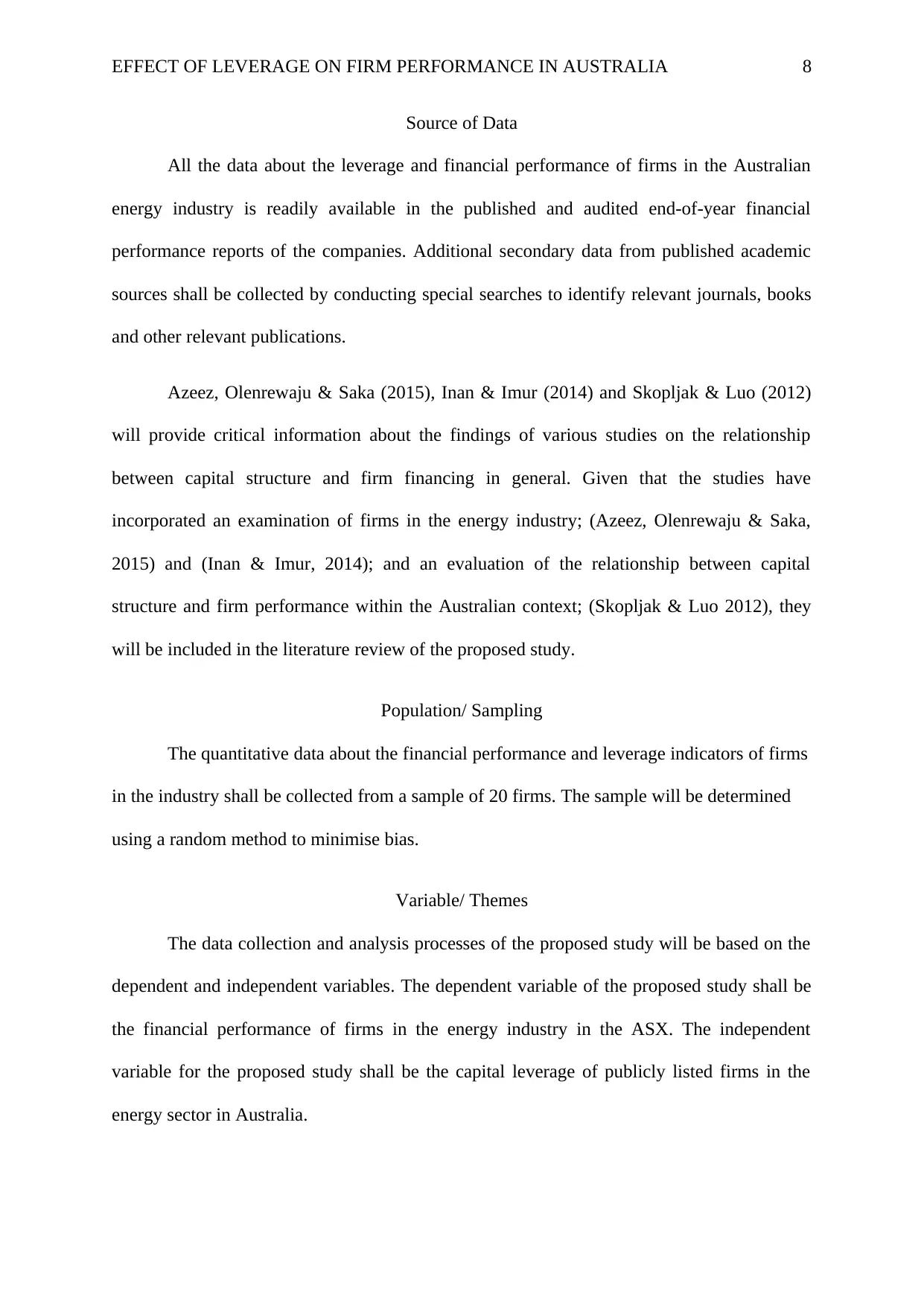
EFFECT OF LEVERAGE ON FIRM PERFORMANCE IN AUSTRALIA 8
Source of Data
All the data about the leverage and financial performance of firms in the Australian
energy industry is readily available in the published and audited end-of-year financial
performance reports of the companies. Additional secondary data from published academic
sources shall be collected by conducting special searches to identify relevant journals, books
and other relevant publications.
Azeez, Olenrewaju & Saka (2015), Inan & Imur (2014) and Skopljak & Luo (2012)
will provide critical information about the findings of various studies on the relationship
between capital structure and firm financing in general. Given that the studies have
incorporated an examination of firms in the energy industry; (Azeez, Olenrewaju & Saka,
2015) and (Inan & Imur, 2014); and an evaluation of the relationship between capital
structure and firm performance within the Australian context; (Skopljak & Luo 2012), they
will be included in the literature review of the proposed study.
Population/ Sampling
The quantitative data about the financial performance and leverage indicators of firms
in the industry shall be collected from a sample of 20 firms. The sample will be determined
using a random method to minimise bias.
Variable/ Themes
The data collection and analysis processes of the proposed study will be based on the
dependent and independent variables. The dependent variable of the proposed study shall be
the financial performance of firms in the energy industry in the ASX. The independent
variable for the proposed study shall be the capital leverage of publicly listed firms in the
energy sector in Australia.
Source of Data
All the data about the leverage and financial performance of firms in the Australian
energy industry is readily available in the published and audited end-of-year financial
performance reports of the companies. Additional secondary data from published academic
sources shall be collected by conducting special searches to identify relevant journals, books
and other relevant publications.
Azeez, Olenrewaju & Saka (2015), Inan & Imur (2014) and Skopljak & Luo (2012)
will provide critical information about the findings of various studies on the relationship
between capital structure and firm financing in general. Given that the studies have
incorporated an examination of firms in the energy industry; (Azeez, Olenrewaju & Saka,
2015) and (Inan & Imur, 2014); and an evaluation of the relationship between capital
structure and firm performance within the Australian context; (Skopljak & Luo 2012), they
will be included in the literature review of the proposed study.
Population/ Sampling
The quantitative data about the financial performance and leverage indicators of firms
in the industry shall be collected from a sample of 20 firms. The sample will be determined
using a random method to minimise bias.
Variable/ Themes
The data collection and analysis processes of the proposed study will be based on the
dependent and independent variables. The dependent variable of the proposed study shall be
the financial performance of firms in the energy industry in the ASX. The independent
variable for the proposed study shall be the capital leverage of publicly listed firms in the
energy sector in Australia.
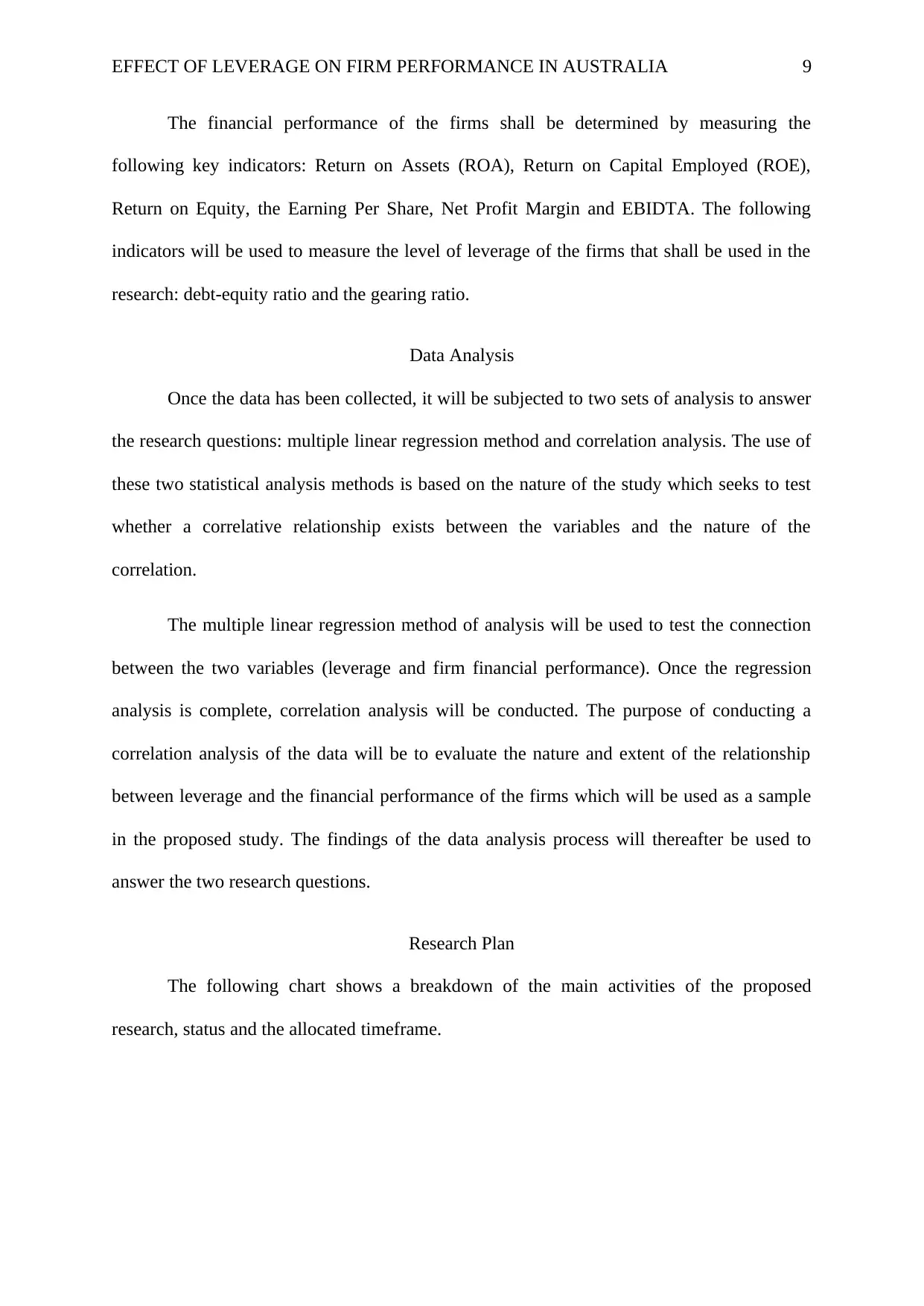
EFFECT OF LEVERAGE ON FIRM PERFORMANCE IN AUSTRALIA 9
The financial performance of the firms shall be determined by measuring the
following key indicators: Return on Assets (ROA), Return on Capital Employed (ROE),
Return on Equity, the Earning Per Share, Net Profit Margin and EBIDTA. The following
indicators will be used to measure the level of leverage of the firms that shall be used in the
research: debt-equity ratio and the gearing ratio.
Data Analysis
Once the data has been collected, it will be subjected to two sets of analysis to answer
the research questions: multiple linear regression method and correlation analysis. The use of
these two statistical analysis methods is based on the nature of the study which seeks to test
whether a correlative relationship exists between the variables and the nature of the
correlation.
The multiple linear regression method of analysis will be used to test the connection
between the two variables (leverage and firm financial performance). Once the regression
analysis is complete, correlation analysis will be conducted. The purpose of conducting a
correlation analysis of the data will be to evaluate the nature and extent of the relationship
between leverage and the financial performance of the firms which will be used as a sample
in the proposed study. The findings of the data analysis process will thereafter be used to
answer the two research questions.
Research Plan
The following chart shows a breakdown of the main activities of the proposed
research, status and the allocated timeframe.
The financial performance of the firms shall be determined by measuring the
following key indicators: Return on Assets (ROA), Return on Capital Employed (ROE),
Return on Equity, the Earning Per Share, Net Profit Margin and EBIDTA. The following
indicators will be used to measure the level of leverage of the firms that shall be used in the
research: debt-equity ratio and the gearing ratio.
Data Analysis
Once the data has been collected, it will be subjected to two sets of analysis to answer
the research questions: multiple linear regression method and correlation analysis. The use of
these two statistical analysis methods is based on the nature of the study which seeks to test
whether a correlative relationship exists between the variables and the nature of the
correlation.
The multiple linear regression method of analysis will be used to test the connection
between the two variables (leverage and firm financial performance). Once the regression
analysis is complete, correlation analysis will be conducted. The purpose of conducting a
correlation analysis of the data will be to evaluate the nature and extent of the relationship
between leverage and the financial performance of the firms which will be used as a sample
in the proposed study. The findings of the data analysis process will thereafter be used to
answer the two research questions.
Research Plan
The following chart shows a breakdown of the main activities of the proposed
research, status and the allocated timeframe.
⊘ This is a preview!⊘
Do you want full access?
Subscribe today to unlock all pages.

Trusted by 1+ million students worldwide
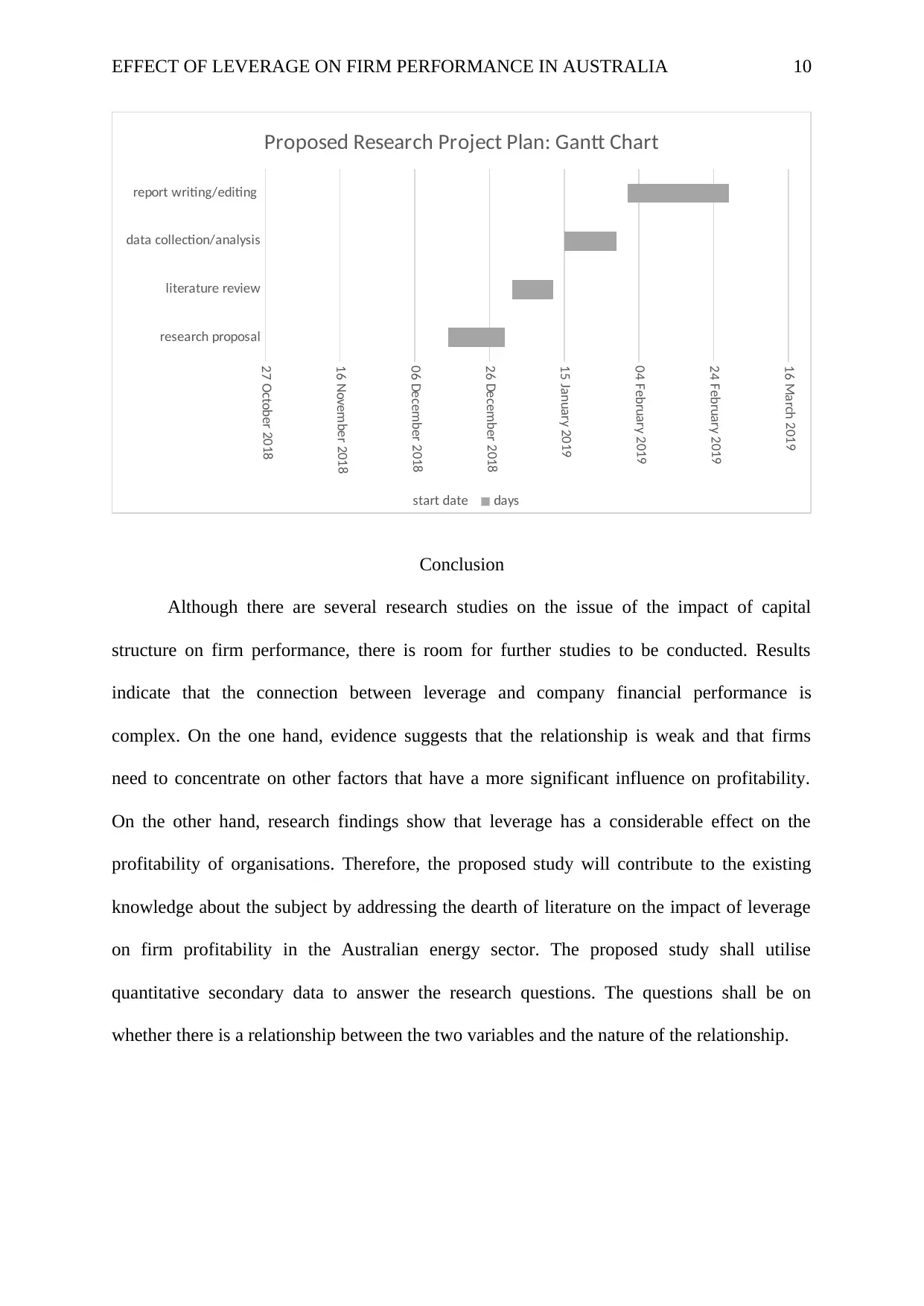
EFFECT OF LEVERAGE ON FIRM PERFORMANCE IN AUSTRALIA 10
research proposal
literature review
data collection/analysis
report writing/editing
27 October 2018
16 November 2018
06 December 2018
26 December 2018
15 January 2019
04 February 2019
24 February 2019
16 March 2019
Proposed Research Project Plan: Gantt Chart
start date days
Conclusion
Although there are several research studies on the issue of the impact of capital
structure on firm performance, there is room for further studies to be conducted. Results
indicate that the connection between leverage and company financial performance is
complex. On the one hand, evidence suggests that the relationship is weak and that firms
need to concentrate on other factors that have a more significant influence on profitability.
On the other hand, research findings show that leverage has a considerable effect on the
profitability of organisations. Therefore, the proposed study will contribute to the existing
knowledge about the subject by addressing the dearth of literature on the impact of leverage
on firm profitability in the Australian energy sector. The proposed study shall utilise
quantitative secondary data to answer the research questions. The questions shall be on
whether there is a relationship between the two variables and the nature of the relationship.
research proposal
literature review
data collection/analysis
report writing/editing
27 October 2018
16 November 2018
06 December 2018
26 December 2018
15 January 2019
04 February 2019
24 February 2019
16 March 2019
Proposed Research Project Plan: Gantt Chart
start date days
Conclusion
Although there are several research studies on the issue of the impact of capital
structure on firm performance, there is room for further studies to be conducted. Results
indicate that the connection between leverage and company financial performance is
complex. On the one hand, evidence suggests that the relationship is weak and that firms
need to concentrate on other factors that have a more significant influence on profitability.
On the other hand, research findings show that leverage has a considerable effect on the
profitability of organisations. Therefore, the proposed study will contribute to the existing
knowledge about the subject by addressing the dearth of literature on the impact of leverage
on firm profitability in the Australian energy sector. The proposed study shall utilise
quantitative secondary data to answer the research questions. The questions shall be on
whether there is a relationship between the two variables and the nature of the relationship.
Paraphrase This Document
Need a fresh take? Get an instant paraphrase of this document with our AI Paraphraser

EFFECT OF LEVERAGE ON FIRM PERFORMANCE IN AUSTRALIA 11
References
Abosede, A., J. 2012. Pecking Order Theory of Capital Structure: Another Way to Look at It.
Journal of Business Management and Applied Economics, 5, 1 – 11. Retrieved 18
December 2018 from,
http://jbmae.scientificpapers.org/wp-content/files/2030_Abosede_PECKING_ORDER_
THEORY_OF_CAPITAL_STRUCTURE_-
_ANOTHER_WAY_TO_LOOK_AT_IT.pdf
ADX Energy Ltd. 2017. Annual Financial Report. Retrieved 19 December 2018, from,
http://adx-energy.com/documents/annual-report-december-2017.pdf
Atiyet, B, A. 2012. The Pecking Order Theory and the Static Trade-Off Theory: Comparison
of the Alternative Explanatory Power in French Firms. Journal of Business Studies
Quarterly, 4, 1, 1-14. Retrieved 18 December 2018, from,
http://jbsq.org/wp-content/uploads/2012/09/JBSQ_Sept2012-1.pdf
Azeez, O, T., Olanrewaju, E., M. & Saka, A., T. 2015. Impact of Capital Structure on
Corporate Performance: A Pre And Post Crisis Evaluation of Selected Companies In
US. International Journal of Accounting Research, 2, 8, 1-13. Retrieved 19 December
2018, from, https://www.arabianjbmr.com/pdfs/AC_VOL_2_8/1.pdf
Bonazzi, L. & Islam, N., M., S. 2006. Agency theory and corporate governance A study of
the effectiveness of board in their monitoring of the CEO. Journal of Modelling in
Management, 2, 1, 7-23. Retrieved 18 December 2018, from,
https://www.kantakji.com/media/3337/w113.pdf
Cekrezi, A. 2013. A literature review of the trade-off theory of capital structure. Iliria
International Review, 1, 125-134. Retrieved 18 December 2018, from,
References
Abosede, A., J. 2012. Pecking Order Theory of Capital Structure: Another Way to Look at It.
Journal of Business Management and Applied Economics, 5, 1 – 11. Retrieved 18
December 2018 from,
http://jbmae.scientificpapers.org/wp-content/files/2030_Abosede_PECKING_ORDER_
THEORY_OF_CAPITAL_STRUCTURE_-
_ANOTHER_WAY_TO_LOOK_AT_IT.pdf
ADX Energy Ltd. 2017. Annual Financial Report. Retrieved 19 December 2018, from,
http://adx-energy.com/documents/annual-report-december-2017.pdf
Atiyet, B, A. 2012. The Pecking Order Theory and the Static Trade-Off Theory: Comparison
of the Alternative Explanatory Power in French Firms. Journal of Business Studies
Quarterly, 4, 1, 1-14. Retrieved 18 December 2018, from,
http://jbsq.org/wp-content/uploads/2012/09/JBSQ_Sept2012-1.pdf
Azeez, O, T., Olanrewaju, E., M. & Saka, A., T. 2015. Impact of Capital Structure on
Corporate Performance: A Pre And Post Crisis Evaluation of Selected Companies In
US. International Journal of Accounting Research, 2, 8, 1-13. Retrieved 19 December
2018, from, https://www.arabianjbmr.com/pdfs/AC_VOL_2_8/1.pdf
Bonazzi, L. & Islam, N., M., S. 2006. Agency theory and corporate governance A study of
the effectiveness of board in their monitoring of the CEO. Journal of Modelling in
Management, 2, 1, 7-23. Retrieved 18 December 2018, from,
https://www.kantakji.com/media/3337/w113.pdf
Cekrezi, A. 2013. A literature review of the trade-off theory of capital structure. Iliria
International Review, 1, 125-134. Retrieved 18 December 2018, from,
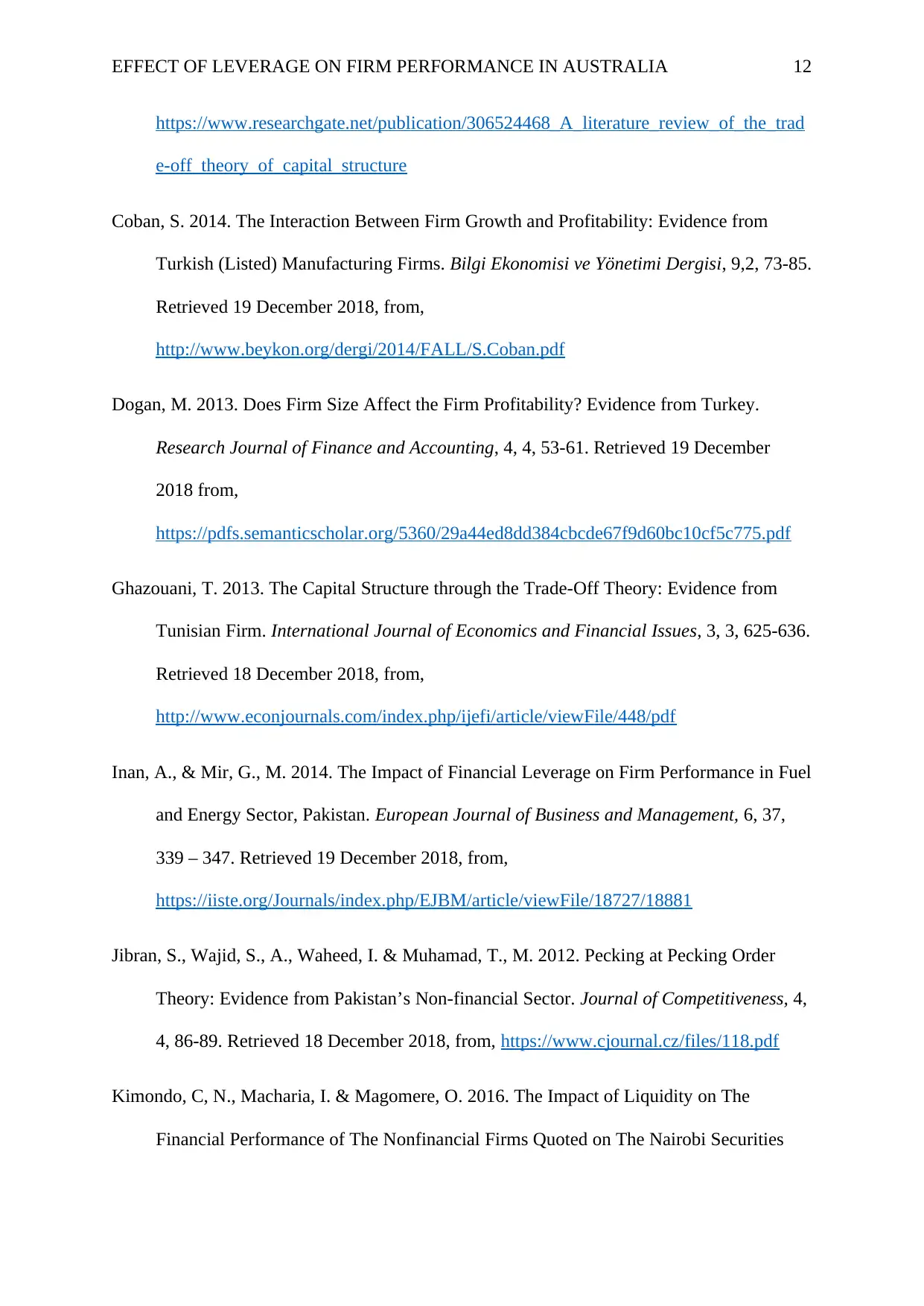
EFFECT OF LEVERAGE ON FIRM PERFORMANCE IN AUSTRALIA 12
https://www.researchgate.net/publication/306524468_A_literature_review_of_the_trad
e-off_theory_of_capital_structure
Coban, S. 2014. The Interaction Between Firm Growth and Profitability: Evidence from
Turkish (Listed) Manufacturing Firms. Bilgi Ekonomisi ve Yönetimi Dergisi, 9,2, 73-85.
Retrieved 19 December 2018, from,
http://www.beykon.org/dergi/2014/FALL/S.Coban.pdf
Dogan, M. 2013. Does Firm Size Affect the Firm Profitability? Evidence from Turkey.
Research Journal of Finance and Accounting, 4, 4, 53-61. Retrieved 19 December
2018 from,
https://pdfs.semanticscholar.org/5360/29a44ed8dd384cbcde67f9d60bc10cf5c775.pdf
Ghazouani, T. 2013. The Capital Structure through the Trade-Off Theory: Evidence from
Tunisian Firm. International Journal of Economics and Financial Issues, 3, 3, 625-636.
Retrieved 18 December 2018, from,
http://www.econjournals.com/index.php/ijefi/article/viewFile/448/pdf
Inan, A., & Mir, G., M. 2014. The Impact of Financial Leverage on Firm Performance in Fuel
and Energy Sector, Pakistan. European Journal of Business and Management, 6, 37,
339 – 347. Retrieved 19 December 2018, from,
https://iiste.org/Journals/index.php/EJBM/article/viewFile/18727/18881
Jibran, S., Wajid, S., A., Waheed, I. & Muhamad, T., M. 2012. Pecking at Pecking Order
Theory: Evidence from Pakistan’s Non-financial Sector. Journal of Competitiveness, 4,
4, 86-89. Retrieved 18 December 2018, from, https://www.cjournal.cz/files/118.pdf
Kimondo, C, N., Macharia, I. & Magomere, O. 2016. The Impact of Liquidity on The
Financial Performance of The Nonfinancial Firms Quoted on The Nairobi Securities
https://www.researchgate.net/publication/306524468_A_literature_review_of_the_trad
e-off_theory_of_capital_structure
Coban, S. 2014. The Interaction Between Firm Growth and Profitability: Evidence from
Turkish (Listed) Manufacturing Firms. Bilgi Ekonomisi ve Yönetimi Dergisi, 9,2, 73-85.
Retrieved 19 December 2018, from,
http://www.beykon.org/dergi/2014/FALL/S.Coban.pdf
Dogan, M. 2013. Does Firm Size Affect the Firm Profitability? Evidence from Turkey.
Research Journal of Finance and Accounting, 4, 4, 53-61. Retrieved 19 December
2018 from,
https://pdfs.semanticscholar.org/5360/29a44ed8dd384cbcde67f9d60bc10cf5c775.pdf
Ghazouani, T. 2013. The Capital Structure through the Trade-Off Theory: Evidence from
Tunisian Firm. International Journal of Economics and Financial Issues, 3, 3, 625-636.
Retrieved 18 December 2018, from,
http://www.econjournals.com/index.php/ijefi/article/viewFile/448/pdf
Inan, A., & Mir, G., M. 2014. The Impact of Financial Leverage on Firm Performance in Fuel
and Energy Sector, Pakistan. European Journal of Business and Management, 6, 37,
339 – 347. Retrieved 19 December 2018, from,
https://iiste.org/Journals/index.php/EJBM/article/viewFile/18727/18881
Jibran, S., Wajid, S., A., Waheed, I. & Muhamad, T., M. 2012. Pecking at Pecking Order
Theory: Evidence from Pakistan’s Non-financial Sector. Journal of Competitiveness, 4,
4, 86-89. Retrieved 18 December 2018, from, https://www.cjournal.cz/files/118.pdf
Kimondo, C, N., Macharia, I. & Magomere, O. 2016. The Impact of Liquidity on The
Financial Performance of The Nonfinancial Firms Quoted on The Nairobi Securities
⊘ This is a preview!⊘
Do you want full access?
Subscribe today to unlock all pages.

Trusted by 1+ million students worldwide
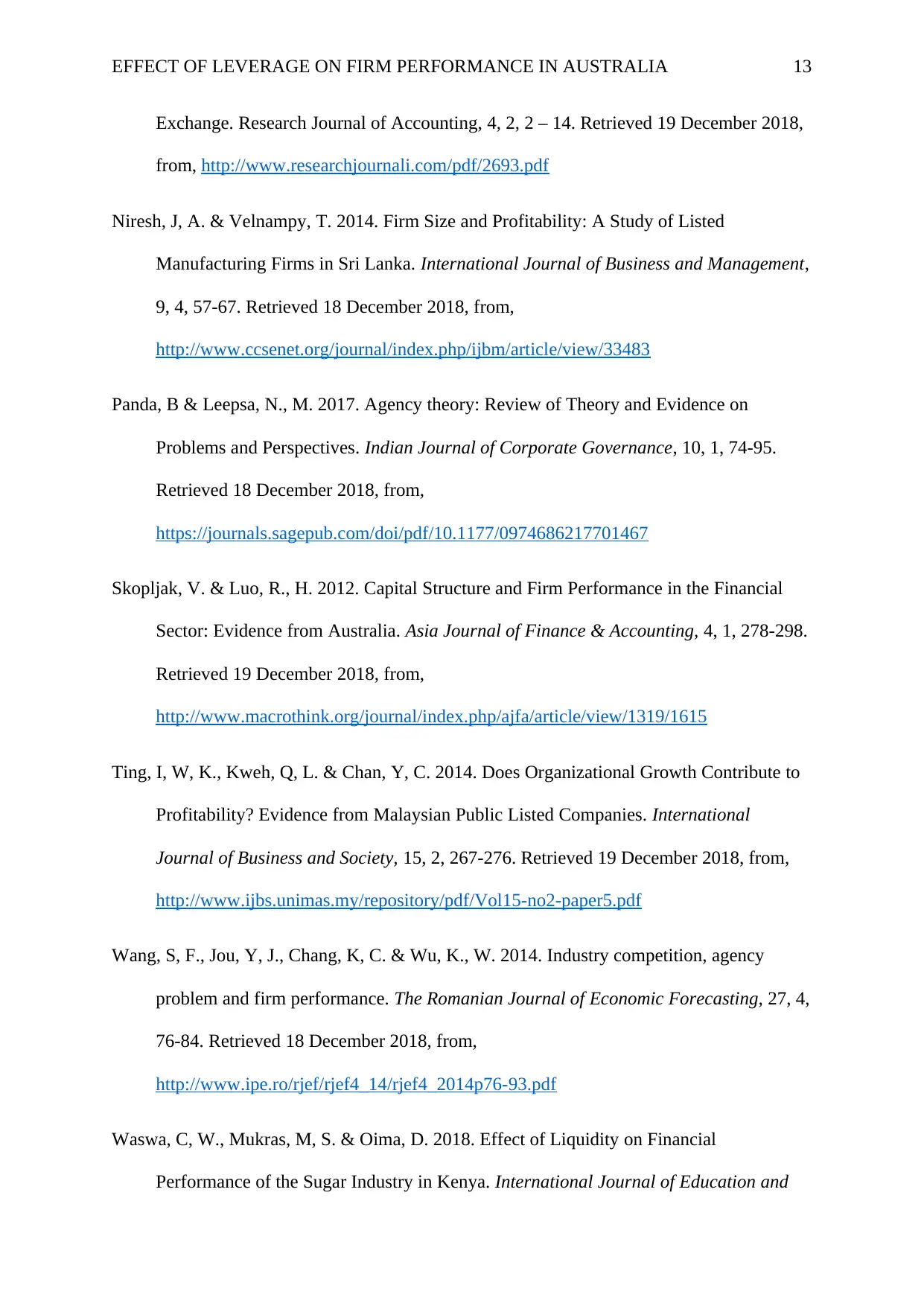
EFFECT OF LEVERAGE ON FIRM PERFORMANCE IN AUSTRALIA 13
Exchange. Research Journal of Accounting, 4, 2, 2 – 14. Retrieved 19 December 2018,
from, http://www.researchjournali.com/pdf/2693.pdf
Niresh, J, A. & Velnampy, T. 2014. Firm Size and Profitability: A Study of Listed
Manufacturing Firms in Sri Lanka. International Journal of Business and Management,
9, 4, 57-67. Retrieved 18 December 2018, from,
http://www.ccsenet.org/journal/index.php/ijbm/article/view/33483
Panda, B & Leepsa, N., M. 2017. Agency theory: Review of Theory and Evidence on
Problems and Perspectives. Indian Journal of Corporate Governance, 10, 1, 74-95.
Retrieved 18 December 2018, from,
https://journals.sagepub.com/doi/pdf/10.1177/0974686217701467
Skopljak, V. & Luo, R., H. 2012. Capital Structure and Firm Performance in the Financial
Sector: Evidence from Australia. Asia Journal of Finance & Accounting, 4, 1, 278-298.
Retrieved 19 December 2018, from,
http://www.macrothink.org/journal/index.php/ajfa/article/view/1319/1615
Ting, I, W, K., Kweh, Q, L. & Chan, Y, C. 2014. Does Organizational Growth Contribute to
Profitability? Evidence from Malaysian Public Listed Companies. International
Journal of Business and Society, 15, 2, 267-276. Retrieved 19 December 2018, from,
http://www.ijbs.unimas.my/repository/pdf/Vol15-no2-paper5.pdf
Wang, S, F., Jou, Y, J., Chang, K, C. & Wu, K., W. 2014. Industry competition, agency
problem and firm performance. The Romanian Journal of Economic Forecasting, 27, 4,
76-84. Retrieved 18 December 2018, from,
http://www.ipe.ro/rjef/rjef4_14/rjef4_2014p76-93.pdf
Waswa, C, W., Mukras, M, S. & Oima, D. 2018. Effect of Liquidity on Financial
Performance of the Sugar Industry in Kenya. International Journal of Education and
Exchange. Research Journal of Accounting, 4, 2, 2 – 14. Retrieved 19 December 2018,
from, http://www.researchjournali.com/pdf/2693.pdf
Niresh, J, A. & Velnampy, T. 2014. Firm Size and Profitability: A Study of Listed
Manufacturing Firms in Sri Lanka. International Journal of Business and Management,
9, 4, 57-67. Retrieved 18 December 2018, from,
http://www.ccsenet.org/journal/index.php/ijbm/article/view/33483
Panda, B & Leepsa, N., M. 2017. Agency theory: Review of Theory and Evidence on
Problems and Perspectives. Indian Journal of Corporate Governance, 10, 1, 74-95.
Retrieved 18 December 2018, from,
https://journals.sagepub.com/doi/pdf/10.1177/0974686217701467
Skopljak, V. & Luo, R., H. 2012. Capital Structure and Firm Performance in the Financial
Sector: Evidence from Australia. Asia Journal of Finance & Accounting, 4, 1, 278-298.
Retrieved 19 December 2018, from,
http://www.macrothink.org/journal/index.php/ajfa/article/view/1319/1615
Ting, I, W, K., Kweh, Q, L. & Chan, Y, C. 2014. Does Organizational Growth Contribute to
Profitability? Evidence from Malaysian Public Listed Companies. International
Journal of Business and Society, 15, 2, 267-276. Retrieved 19 December 2018, from,
http://www.ijbs.unimas.my/repository/pdf/Vol15-no2-paper5.pdf
Wang, S, F., Jou, Y, J., Chang, K, C. & Wu, K., W. 2014. Industry competition, agency
problem and firm performance. The Romanian Journal of Economic Forecasting, 27, 4,
76-84. Retrieved 18 December 2018, from,
http://www.ipe.ro/rjef/rjef4_14/rjef4_2014p76-93.pdf
Waswa, C, W., Mukras, M, S. & Oima, D. 2018. Effect of Liquidity on Financial
Performance of the Sugar Industry in Kenya. International Journal of Education and
Paraphrase This Document
Need a fresh take? Get an instant paraphrase of this document with our AI Paraphraser
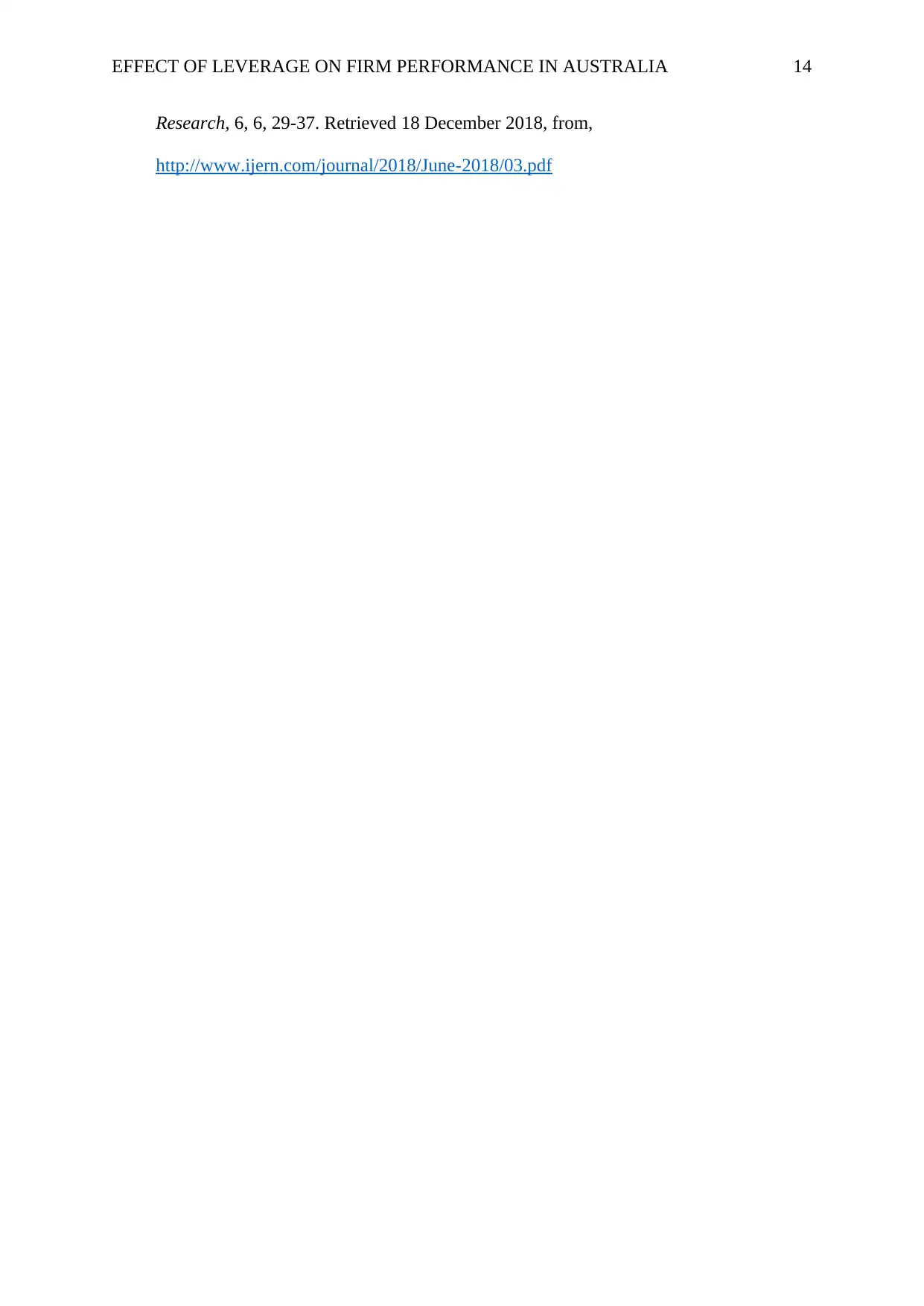
EFFECT OF LEVERAGE ON FIRM PERFORMANCE IN AUSTRALIA 14
Research, 6, 6, 29-37. Retrieved 18 December 2018, from,
http://www.ijern.com/journal/2018/June-2018/03.pdf
Research, 6, 6, 29-37. Retrieved 18 December 2018, from,
http://www.ijern.com/journal/2018/June-2018/03.pdf
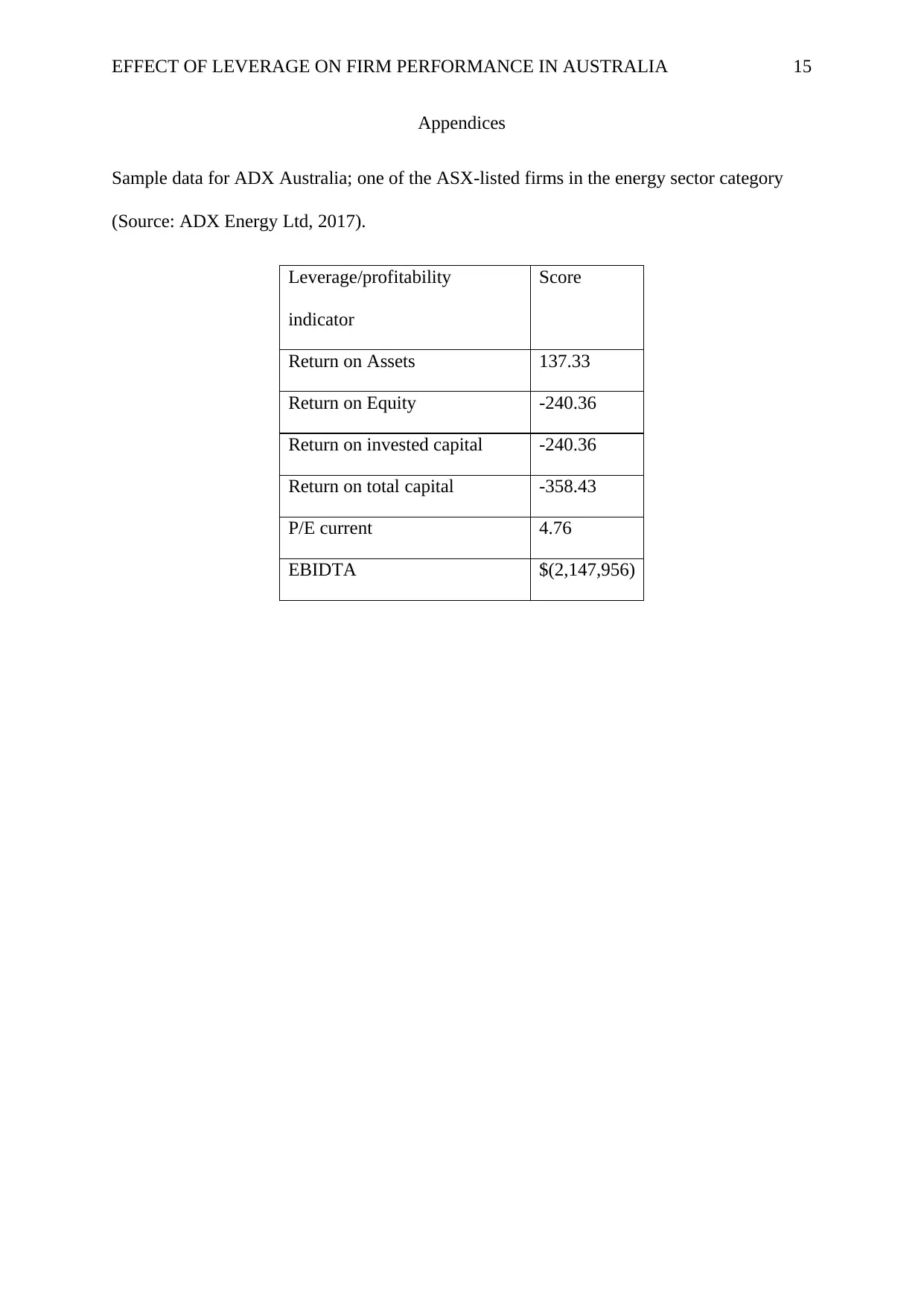
EFFECT OF LEVERAGE ON FIRM PERFORMANCE IN AUSTRALIA 15
Appendices
Sample data for ADX Australia; one of the ASX-listed firms in the energy sector category
(Source: ADX Energy Ltd, 2017).
Leverage/profitability
indicator
Score
Return on Assets 137.33
Return on Equity -240.36
Return on invested capital -240.36
Return on total capital -358.43
P/E current 4.76
EBIDTA $(2,147,956)
Appendices
Sample data for ADX Australia; one of the ASX-listed firms in the energy sector category
(Source: ADX Energy Ltd, 2017).
Leverage/profitability
indicator
Score
Return on Assets 137.33
Return on Equity -240.36
Return on invested capital -240.36
Return on total capital -358.43
P/E current 4.76
EBIDTA $(2,147,956)
⊘ This is a preview!⊘
Do you want full access?
Subscribe today to unlock all pages.

Trusted by 1+ million students worldwide
1 out of 15
Related Documents
Your All-in-One AI-Powered Toolkit for Academic Success.
+13062052269
info@desklib.com
Available 24*7 on WhatsApp / Email
![[object Object]](/_next/static/media/star-bottom.7253800d.svg)
Unlock your academic potential
© 2024 | Zucol Services PVT LTD | All rights reserved.





